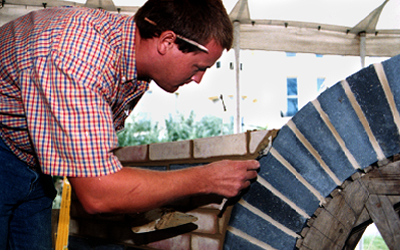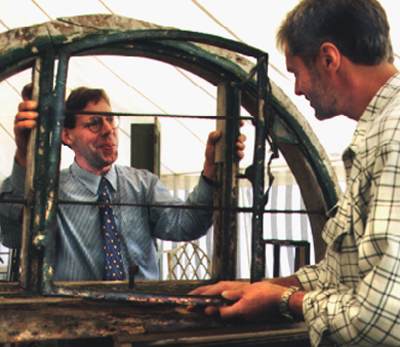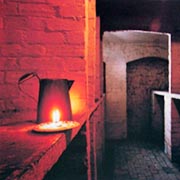Care of the exteriors of historic homes
Bricks and Mortar | Roofs | Windows and doors | Ironwork | Stucco
Historic buildings should be checked regularly and any maintenance work carried out immediately. Any minor damage left unattended soon escalates into more serious structural problems.
An archaeological survey should be undertaken and advice sought from specialists before work is undertaken. Repairs are best done using traditional methods and matching materials, new methods and materials should only be used if tried and tested and sympathetic to the character of the building.
Bricks and Mortar
Brick deteriorates for a variety of reasons, the most likely cause being weathering as a result of wind driven rain, with buildings on exposed sites being particularly vulnerable. Sound brickwork at lower levels may not reflect the condition of more exposed parts of the building. Pollution and sulphation can build up on the brickwork interfering with the porosity of the brick and resulting in surface damage.

Above: 'Pointing' - repairing mortar.
Cleaning can be undertaken by water washing, chemical treatments and abrasive cleaning. Abrasive methods should be used under very controlled conditions and at a very low pressure, abrasives such as calcium carbonate or calcium chloride are used in dust form and are good as they do not leave any residual chemicals on the brick work.
If individual bricks are damaged they can be removed and replaced with new pointing, sympathetic to the original mortar. Mortar should be made so that it is weaker than the variety of brick that it is jointing, this allows for the subsequent movement of the building. Complete repointing of the wall will help to blend in new brickwork, the patching of new and old mortars should be avoided. Any new bricks should match originals in both colour and texture.
Roofs
It is vital to keep the roof of a building in good repair as moisture ingress can seriously damage the structure of the building. The Sussex coast is very exposed, so tiles and slates need to be fixed properly to avoid damage form the wind and rain.
Welsh slates or Wealden clay roof tiles can often outlive the nails used to keep them in place. This means that tiles or slates can often be reused, but try to avoid the patchiness caused when mixing materials from various sources.
Lead is still one of the most effective roofing materials for flat roofs. The natural thermal movement of lead must be taken into consideration when it is laid. Advice should always be taken and the Lead Sheet Associations’ guidelines adhered to.
Conversion of roof spaces should never compromise the exterior appearance of roofs. Roof lights should be set flush and only placed on rear aspect of the building.
Original chimney stacks can strongly influence the appearance of a building and should be retained if possible.
Windows and doors
The design and detail of doors and windows are fundamental to the facade of an historic building and it is best to repair, rather than replace them.

Replacement windows should be in matching materials, with an appropriate size and arrangement of the panes and thickness of the glazing bars.
Doors should be designed and made sympathetically, with increasingly scarce original door furniture salvaged for reuse.
Ironwork
Decorative cast and wrought iron is a distinctive feature of the historic homes in this area. Local iron foundries are able to take patterns from existing iron work and create copies. Fractures should be welded by ‘stitching’ the sections together rather than using unsightly modern fixings. During such repair works, original ironwork should be disturbed as little as possible as it can be extremely brittle.
The most serious problem with iron is corrosion, but this can largely be prevented with correct maintenance procedures. Ironwork should be cleaned thoroughly before painting and then treated with primer, undercoats and topcoats as recommended by the paint manufacturers.
Stucco
Stucco or render is not a robust material and, as with many parts of an old building, problem areas need attention before the damage becomes advanced and more costly. The stucco needs to be thoroughly examined before painting and all decorative moulding carefully looked at for any signs of decay.
The moulded features are a vital part of the facade of an historic house and should not be removed but kept in good condition, with repair work carried out by specialists. The features should never be omitted during rebuilding work and time should be given to these details before repainting commences.
When repairing stucco it should be cut out and squared off neatly to existing lines or the edges of architectural details. New render should be built up in three coats. It should be of a similar strength and hardness to the original material, otherwise it may tend to pull away the surrounding render.



